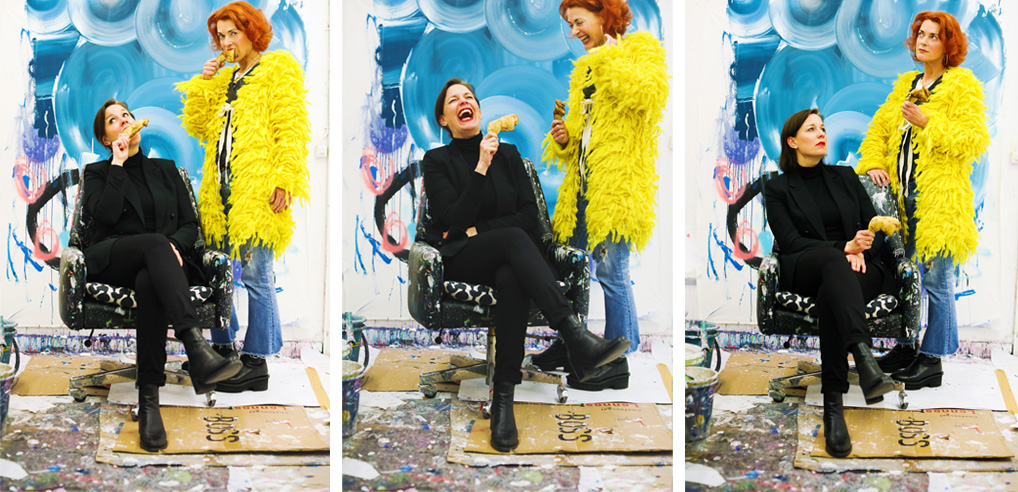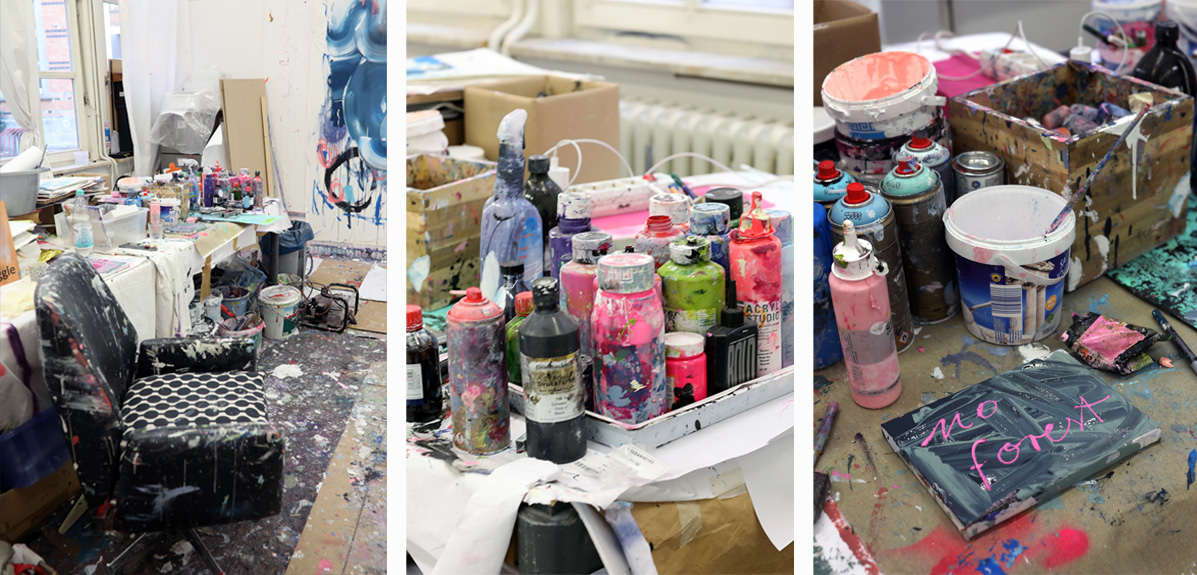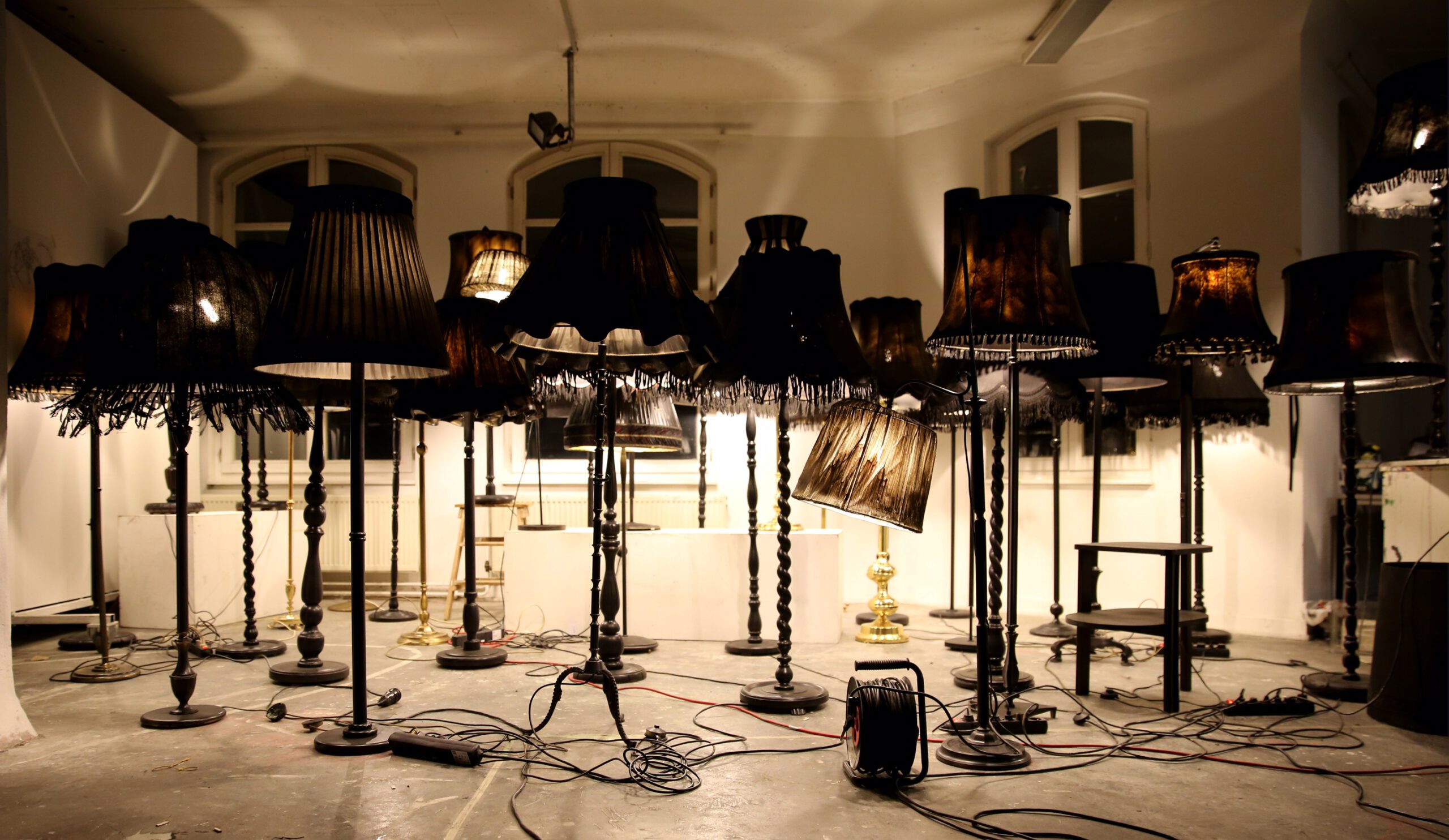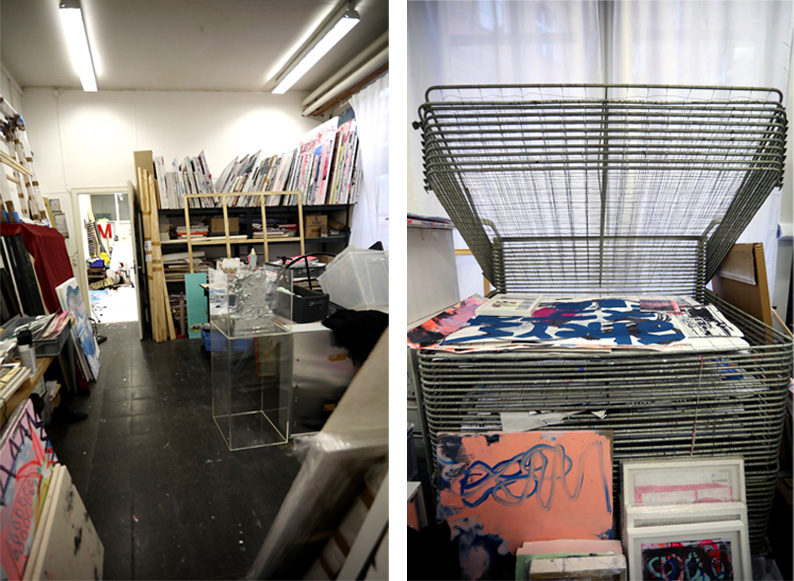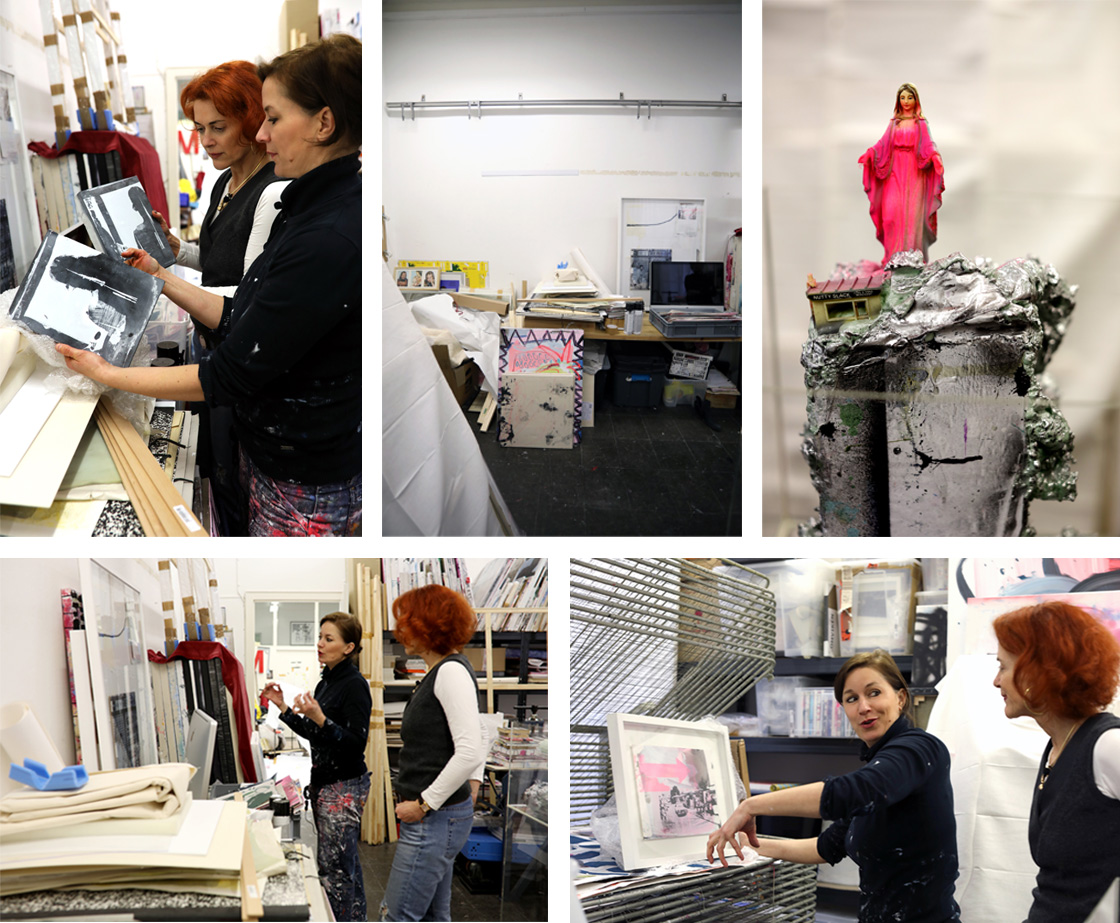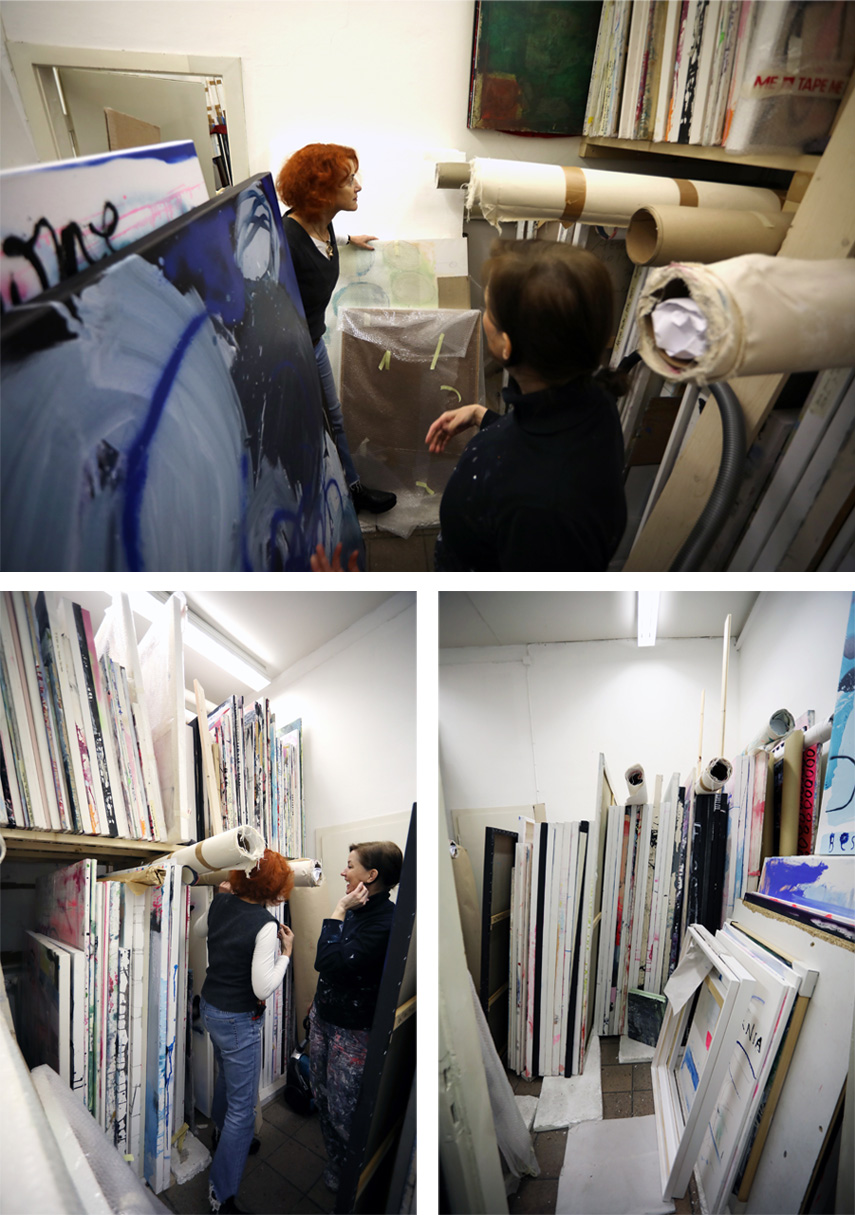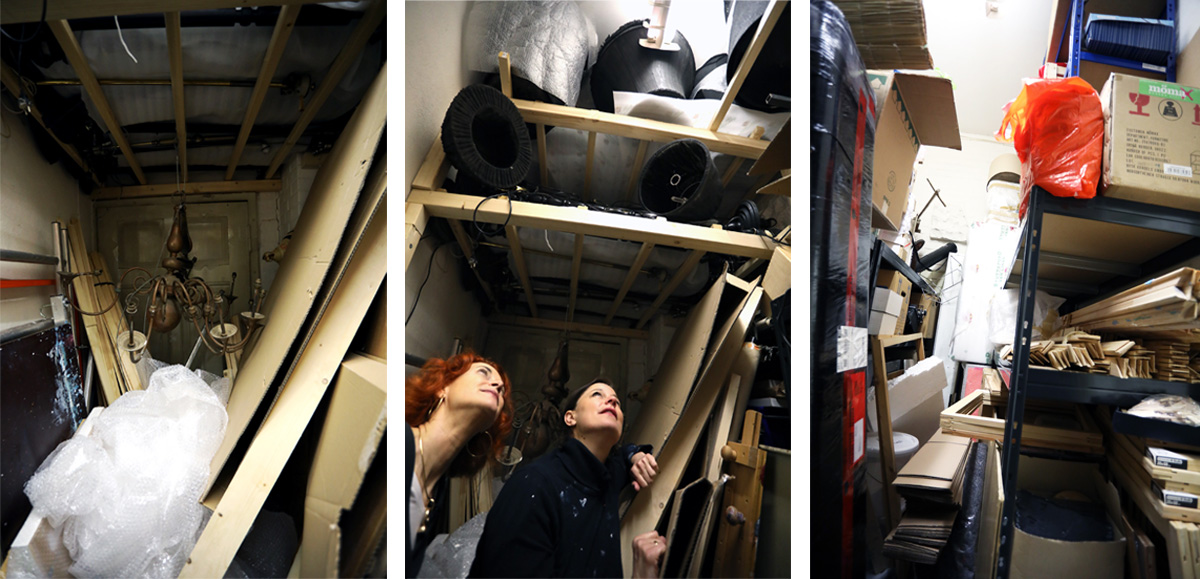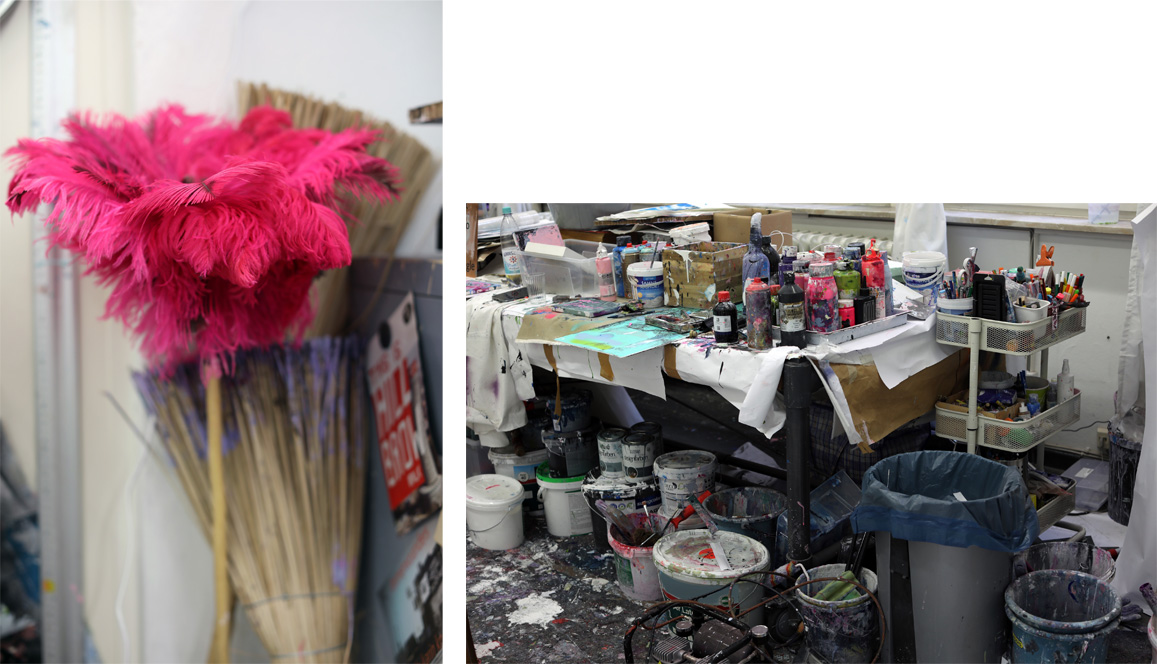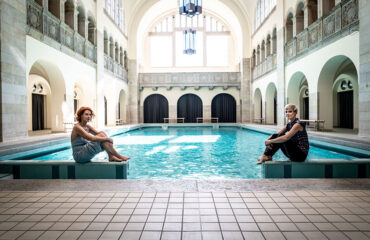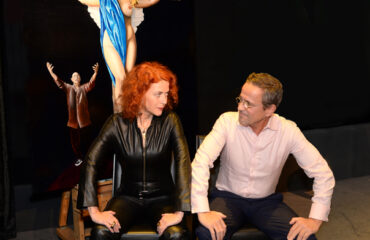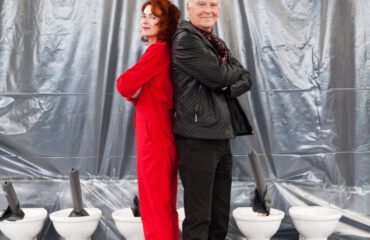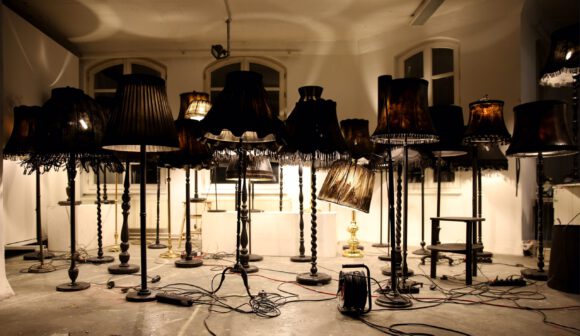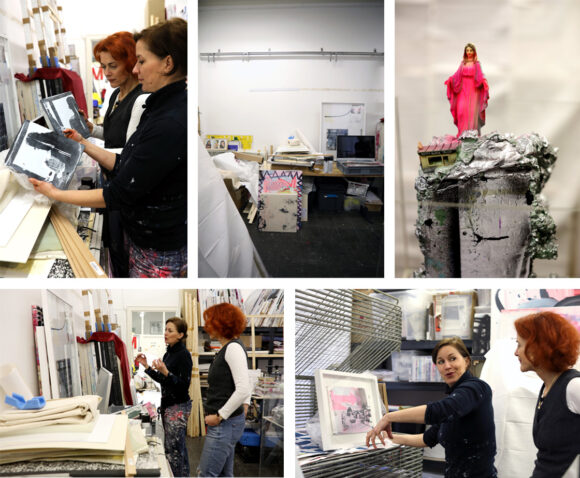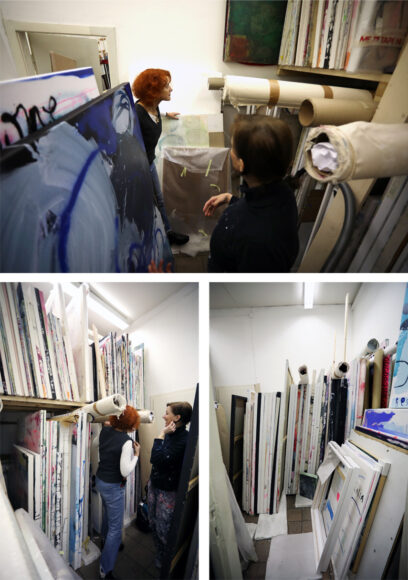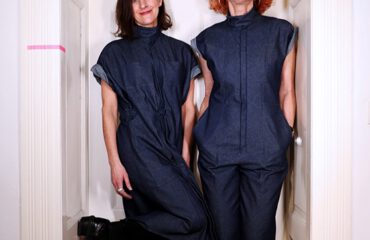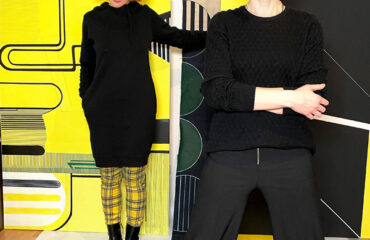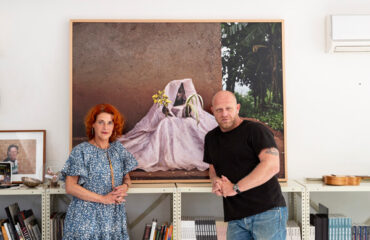Photos: Natascha Romboy
Brunswick. Yes! That’s exactly how I had imagined it. I think, as I enter Manuela Karin Knaut’s studio. A mix of paint buckets, paint tubes, spray bottles, oil chalk, wooden slats, canvases, photographs, paper rolls, foils, indefinable odds and ends, and of course splashes of color everywhere you look, reflect the explosive nature of her work in absolutely every corner of the room. Here in this studio there are mixed, stirred and layered materials that have been experimented with.
Brunswick. Yes! That’s exactly how I had imagined it. I think, as I enter Manuela Karin Knaut’s studio. A mix of paint buckets, paint tubes, spray bottles, oil chalk, wooden slats, canvases, photographs, paper rolls, foils, indefinable odds and ends, and of course splashes of color everywhere you look, reflect the explosive nature of her work in absolutely every corner of the room. Here in this studio there are mixed, stirred and layered materials that have been experimented with.
Studio views
Knaut is one of the most successful artists in the increasingly assertive online art market. Her works, which are now sold in almost every continent, reveal elements of both street art and “objet trouvé” (found objects turned into art). However, they cannot be easily categorized. It is as if the artwork itself asked not to be classified. All of her works radiate and make it exciting for me, once again, to find out whether and to what extent the personality of the artist reveals itself.
left: Safe Travels (2019), right: Bohemian Exiles of LA (2020)
Light- and Soundinstallation The old ladies (2014)
“The current state of the studio is half-tidy. Usually, there are more obstacles when moving around here”, she tells me with a laugh after I manage to find a paint free spot for my equipment. My first question is obvious:
E.B.: Would you like to have more space?
Knaut: That would be nice, of course; specially to be able to work on a larger scale. Actually, the studio was only planned as a temporary solution, as a storage for the many things I brought with me, after I finished my studies in Johannesburg. But at some point I realized that the location, with its proximity to the city center and tranquility, generated very good working conditions for me. I was able to set up and use the individual rooms according to my working process.
E.B.: Is there actually a recurring working process? Your work suggest a rather spontaneous and unstructured development process.
Knaut: That is also the case. But I always work in parallel on different artworks or cycles of different techniques. That’s why I paint here and print or sculpt in the next room. Before the artwork is finished, I put it away again and again for a while until I continue working on it. That’s why I need different storage spaces. It’s best if we just go through it together.
Said and done. We go into the next room. You can actually see a printing press in the midst of bulging baskets, boxes and rolled canvases. A cage-like drying rack for prints functions as a storage area for works on paper. Other works are ready for shipment; temporarily stored and sculptural works await further processing. A screen printing station is yet to be discovered. In a state of confusion, I eagerly wait for explanations.
Print- and sculptor workshop
Knaut: I am an unorthodox painter as well as an unorthodox printer. I use the printing press for everything. The same process I use for my paintings, I also use for my prints. The artwork is always created in layers. In silkscreen printing, for example, an image is first printed on a given material, then something is glued over, sewn on, mounted or whatever. In both pictorial and sculptural work, I always work in many layers.
Here we see a work that combines quite a few of my techniques. Found materials, specially those associated with a narrative, always play an essential role. In this case, an old styrofoam board that was lying around in my former studio in Johannesburg formed the basis the current process. I wanted to use exactly that and not a new one, because it reminded me so much of the streets over there. Then a photograph taken in the immediate vicinity of my studio fell into my hands. In a combination of painting and silkscreen technique, I then overlaid it several times, connected all the elements in a kind of assemblage and finally framed it in this noble way. For me, the overall ensemble wonderfully reflects the view behind the beautiful scenery.
Explanations to materials and techniques
E.B.: Where does your fascination for trashy things come from?
Knaut: It’s my fascination for real life. I don’t like to be dazzled. I like to look behind the facade in the truest sense of the word, and I tend to be fascinated by things that are not appealing at first glance. Even as a child, and later on during my travels, it always appealed to me to get off the beaten track and to discover the area.
E.B.: Is that why out of all cities you decided to study installation art in Johannesburg?
Knaut: The city indeed has a very rough charm. It requires courage to live a life outside the white suburbs behind high walls. I was in my mid-forties and asked myself several times whether I should really leave my comfort zone and take that step. But that’s exactly what my life is about. Whenever things got too comfortable, something new had to come along. Studying in this special place, in this professional way – accompanied by my l family – made me very happy and, in retrospect, took me a long way artistically.
We continue. The next door is opened. Here I would like to be allowed to help myself. In row after row, finished works fill the shelves and the floor space. Getting through is hardly possible – but necessary! For there is another, very special room hidden behind it …
Painting storage
Knaut: The components of previous installations or sculptural works are stored here. Up there, for example, you can see a chandelier from the legendary Alhambra Theatre in Johannesburg. Next to it, forty lamps that were part of my sound installation Old ladies (see picture above), or over there elements of an installation I made in France. All in all, there are all kinds of things here that have a special history in them or materials that I need or could use to build new installations. I simply can not part with anything. For me, my photographs and things capture moments and special moods.
Installation art-storage
E.B.: Are these the moods that you incorporate into your art?
Knaut: Absolutely. I know exactly the mood I felt with each picture. Each one reflects spontaneous moments and the idea of wanting to try something new. It’s an ongoing trial and error. I like the idea of a glitch, of everything not working well. That’s when it gets interesting for me. There has to be a quirk, an eye-catcher. That’s the perfect moment for me to start all over.
Meanwhile back in the painting studio, I notice the colorful brooms standing in the corner.
E.B.: Do you have an idea how you are going to use these brooms for?
Knaut: Of course [laughs]. They are also a souvenir from South Africa. I use them as brushes, which I also do with many other everyday objects, such as foam mattresses. I cut them apart, build brushes out of them and use them to create wonderful textures on the canvas. I work as unconventionally as with my paints. I use cooking oil, discarded paints from construction sites, plaster elements, putties, deep primer…simply everything.
Brooms used as brushes, Colour-„mixing-desk“
E.B.: What is your claim to harmony?
Knaut: I deliberately disregard the classical idea of harmony in painting. Whenever it becomes too beautiful, a stroke or something else is added or something is messed up. This can also be applied to my way of living and thinking. The people who are too beautiful or too nice, where everything is right, are not the ones who interest me. So: where am I drawn? Or in other words: where do I want to go? Not to the most beautiful hotels, nor to the most beautiful beach fronts. Basically, I’m looking for something else …
What was it about not wanting to be pigeonholed, I ask myself again. Even if her works contains elements of well-known art styles, it is above all Knaut herself who becomes the mirror of her own unique body of art…
P.S.: The idea of using the chicken legs, I had brought as snacks for the trip, as a prop for the cover photo arose immediately after I put on my yellow jacket. Whose idea was it? Is it necessary to say it?
Further Information
Artist’s website: https://knaut-contemporary.com
